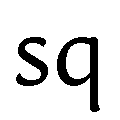

Volume 21 (2002)
Distribution of phosphorus and heavy metals in the
sediments of Lake Arendsee (Altmark, Germany)
Dieter
Wolfram Zachmann, Andrea van der Veen, Susanna Müller
Lake
Arendsee is a dimictic lake with a surface area of about
5 km² and a maximum depth of about 50 m. Due to the
input of untreated sewage rich in P the lake turned to eutrophic state
in the 1950s. Sediment cores were taken by different methods: short
cores (0–50 cm) with a gravity corer, long cores
(0–160 cm) with a piston corer. The sediments were sliced
into subsamples under argon atmosphere in a glove box. The samples were
analysed by ICP-OES and ICP-MS on main and trace elements after
digestion in either aqua regia or HF-HNO3-HClO4.
Analogous cores were dated by varve counting and radiometric methods.
The enforced build-up of industry and agriculture since the 1950s is
displayed in the sediment composition. The P concentrations increase
from a background of about 600 ppm (oligotrophic state of the
lake) to more than 4,000 ppm in a depth of 14 cm, which
corresponds to the 1970s. In 1976, a hypolimnetic withdrawal and a
sewage plant were built. Above the corresponding depth the
concentrations of P and heavy elements decrease in the sediments but
are still by far higher than the background values. The bonding form
analyses document mineral equilibration by diagenetic processes. Stable
sulfidic bonding forms become predominant with increasing depth.
| Editor-in-Chief: | Tomasz Goslar |
| Co-Editors: | Małgorzata Latałowa Wojciech Stankowski Krystyna Szeroczyńska |
| Secretary |
Mariusz Lamentowicz |